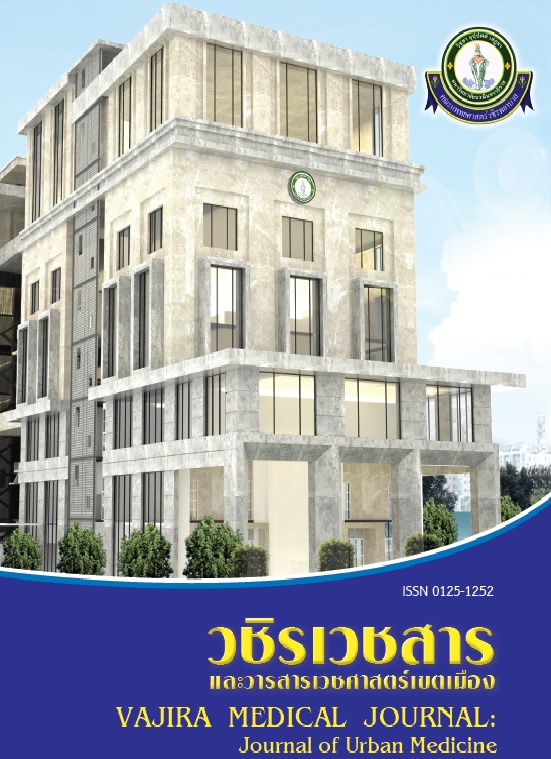Clinical Characteristics and outcome of HIV-positive and HIV-negative related with Diffuse Large B-cell lymphoma at Faculty of Medicine Vajira hospital, Navamindradhiraj University
Main Article Content
Abstract
Objective: The aim of this study was to identify the differences in clinical characteristics, laboratory investigations and clinical outcomes after treatment with CHOP or R-CHOP between HIV-positive and HIV-negative patients and the association with diffuse large B-cell lymphoma at Faculty of Medicine Vajira Hospital.
Methods: This study was a retrospective cohort study of all patients diagnosed with diffuse large B-cell lymphoma at the Department of Internal Medicine, Faculty of Medicine, Vajira Hospital between January 1, 2010 and December 31, 2016. All patients were treated with either CHOP or R-CHOP for at least 4 cycles. The inclusion criteria were at least 15 years of age, HIV-infected, and receiving antiretroviral therapy. The exclusion criteria were a lack of pathological confirmation, the absence of HIV testing results, and the absence of laboratory investigation or radiological imaging, such as the computer tomography of the chest, the abdomen and bone marrow study.
Results: There were 12 patients with HIV-related diffuse large B-cell lymphoma (DLBCL) (11.1%) and 96 patients with non-HIV related DLBCL (88.9%). HIV-infected DLBCL patients had a higher mortality rate than non-HIV related DLBCL patients, 4 patients died in the HIV-positive group (33.3%), while 6 patients died in the HIV-negative group (6.2%) (p-value, OR (95% CI) = 0.034, 5.177 (1.132-23.670)). The HIV-related DLBCL group was younger and had worse prognoses than the other group. Moreover, the HIV-positive group usually had an advanced stage of lymphoma and elevated LDH. However, the response rate after chemotherapy was not significantly different when comparing the 2 groups. (p-value, OR (95% CI) = 0.777, 0.0825 (0.218-3.128).
Conclusion: Patients with HIV-related diffuse large B-cell lymphoma have a higher mortality and more aggressive clinical-biological features than those without HIV with diffuse large B-cell lymphoma. However, there is no difference in the clinical response to treatments between the two groups.
Downloads
Article Details
References
2. Cote TR, Biggar RJ, Rosenberg PS, Devesa SS, Percy C, Yellin FJ, et al. Non-Hodgkin's lymphoma among people with AIDS: incidence, presentation and public health burden. AIDS/Cancer Study Group. Int J Cancer. 1997;73(5):645-50.
3. Little RF, Gutierrez M, Jaffe ES, Pau A, Horne M, Wilson W. HIV-associated non-Hodgkin lymphoma: incidence, presentation, and prognosis. JAMA. 2001;285(14):1880-5.
4. Ratner L, Lee J, Tang S, Redden D, Hamzeh F, Herndier B, et al. Chemotherapy for human immunodeficiency virus-associated non-Hodgkin's lymphoma in combination with highly active antiretroviral therapy. J Clin Oncol. 2001;19(8):2171-8.
5. Harris NL, Jaffe ES, Diebold J, Flandrin G, Muller-Hermelink HK, Vardiman J, et al. World Health Organization classification of neoplastic diseases of the hematopoietic and lymphoid tissues: report of the Clinical Advisory Committee meeting-Airlie House, Virginia, November 1997. J Clin Oncol. 1999;17(12):3835-49.
6. Carbone PP, Kaplan HS, Musshoff K, Smithers DW, Tubiana M. Report of the Committee on Hodgkin's Disease Staging Classification. Cancer Res. 1971;31(11):1860-1.
7. Oken MM, Creech RH, Tormey DC, Horton J, Davis TE, McFadden ET, et al. Toxicity and response criteria of the Eastern Cooperative Oncology Group. Am J Clin Oncol. 1982;5(6):649-55.
8. A predictive model for aggressive non-Hodgkin's lymphoma. The International Non-Hodgkin's Lymphoma Prognostic Factors Project. N Engl J Med. 1993;329(14):987-94.
9. Blay J, Gomez F, Sebban C, Bachelot T, Biron P, Guglielmi C, et al. The International Prognostic Index correlates to survival in patients with aggressive lymphoma in relapse: analysis of the PARMA trial. Parma Group. Blood.1998;92(10):3562-8.
10. Bower M, Gazzard B, Mandalia S, Newsom-Davis T, Thirlwell C, Dhillon T, et al. A prognostic index for systemic AIDS-related non-Hodgkin lymphoma treated in the era of highly active antiretroviral therapy. Ann Intern Med. 2005;143(4):265-73.
11. Mounier N, Spina M, Gabarre J, Raphael M, Rizzardini G, Golfier JB, et al. AIDS-related non-Hodgkin lymphoma: final analysis of 485 patients treated with risk-adapted intensive chemotherapy. Blood. 2006;107(10):3832-40.
12. Kaplan LD, Lee JY, Ambinder RF, Sparano JA, Cesarman E, Chadburn A, et al. Rituximab does not improve clinical outcome in a randomized phase 3 trial of CHOP with or without rituximab in patients with HIV-associated non-Hodgkin lymphoma: AIDS-Malignancies Consortium Trial 010. Blood. 2005;106(5):1538-43.
13. Baptista MJ, Garcia O, Morgades M, Gonzalez-Barca E, Miralles P, Lopez-Guillermo A, et al. HIV-infection impact on clinical-biological features and outcome of diffuse large B-cell lymphoma treated with R-CHOP in the combination antiretroviral therapy era. AIDS. 2015;29(7):811-8.
14. Cheson BD, Pfistner B, Juweid ME, Gascoyne RD, Specht L, Horning SJ, et al. Revised response criteria for malignant lymphoma. J Clin Oncol. 2007;25(5):579-86.
15. Chao C, Xu L, Abrams D, Leyden W, Horberg M, Towner W, et al. Survival of non-Hodgkin lymphoma patients with and without HIV infection in the era of combined antiretroviral therapy. AIDS. 2010;24(11):1765-70.
16. Coutinho R, Pria AD, Gandhi S, Bailey K, Fields P, K, et al. HIV status does not impair the outcome of patients diagnosed with diffuse large B-cell lymphoma treated with R-CHOP in the cART era. AIDS. 2014;28(5):689-97.


